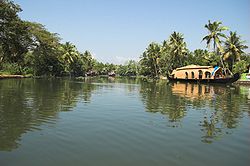
Backwater (river)
Encyclopedia
A backwater is a part of a river in which there is little or no current. It refers either to a branch of a main river which lies alongside it and then rejoins it or to a body of water in a main river which is backed up by an obstruction such as the tide or a dam.
 If a river has developed one or more alternative courses in its evolution, then one channel is usually designated the main course and secondary channels may be termed backwaters. The main river course will usually have the fastest stream and will for example be a main navigation route, whereas backwaters may be more shallow and flow more slowly if at all. This results in a more diverse environment that is of scientific interest and worthy of preservation. Backwaters also provide opportunities for leisure activities such as canoeing and fishing.
If a river has developed one or more alternative courses in its evolution, then one channel is usually designated the main course and secondary channels may be termed backwaters. The main river course will usually have the fastest stream and will for example be a main navigation route, whereas backwaters may be more shallow and flow more slowly if at all. This results in a more diverse environment that is of scientific interest and worthy of preservation. Backwaters also provide opportunities for leisure activities such as canoeing and fishing.
In this sense the term is used by extension to apply to physical and social areas that have been by-passed. It may apply to places that have been neglected in economic development or in the expression a "cultural backwater".
 When a section of a river
When a section of a river
is near the coast
or another feature that sets its base level
, then the section which is influenced by the conditions at its mouth is termed a backwater. If a river flows into a lake or sea, this is the region in which the slope of the river decreases because the lower water flux
permitted at the mouth causes the water to back up. Where the river outlet is strongly affected by tides, this cyclic change in base level changes the portion of the river that is a backwater. As a result fresh and salt water may become mixed to form an estuarine
environment.
Alternative channel

In this sense the term is used by extension to apply to physical and social areas that have been by-passed. It may apply to places that have been neglected in economic development or in the expression a "cultural backwater".
Water backed up by an obstruction

River
A river is a natural watercourse, usually freshwater, flowing towards an ocean, a lake, a sea, or another river. In a few cases, a river simply flows into the ground or dries up completely before reaching another body of water. Small rivers may also be called by several other names, including...
is near the coast
Coast
A coastline or seashore is the area where land meets the sea or ocean. A precise line that can be called a coastline cannot be determined due to the dynamic nature of tides. The term "coastal zone" can be used instead, which is a spatial zone where interaction of the sea and land processes occurs...
or another feature that sets its base level
Base level
The base level of a river or stream is the lowest point to which it can flow, often referred to as the 'mouth' of the river. For large rivers, sea level is usually the base level, but a large river or lake is likewise the base level for tributary streams...
, then the section which is influenced by the conditions at its mouth is termed a backwater. If a river flows into a lake or sea, this is the region in which the slope of the river decreases because the lower water flux
Flux
In the various subfields of physics, there exist two common usages of the term flux, both with rigorous mathematical frameworks.* In the study of transport phenomena , flux is defined as flow per unit area, where flow is the movement of some quantity per time...
permitted at the mouth causes the water to back up. Where the river outlet is strongly affected by tides, this cyclic change in base level changes the portion of the river that is a backwater. As a result fresh and salt water may become mixed to form an estuarine
Estuary
An estuary is a partly enclosed coastal body of water with one or more rivers or streams flowing into it, and with a free connection to the open sea....
environment.

